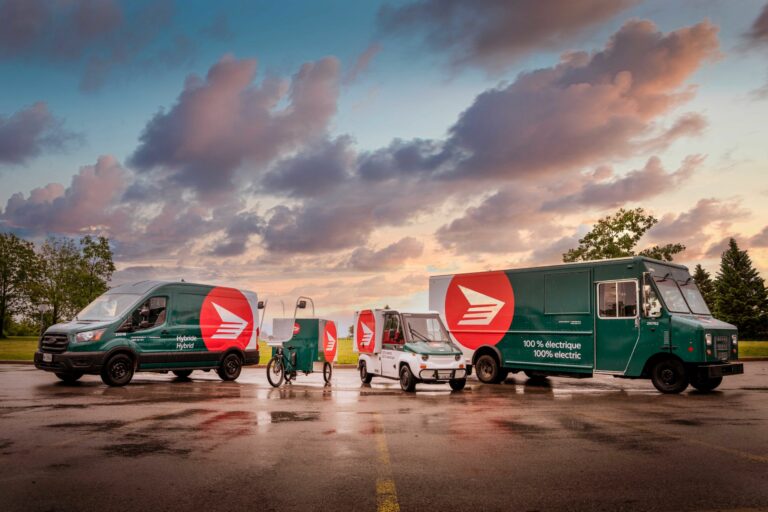SUSTAINABLE MAIL GROUP INTERVIEW
Cheryl Hodder, Chief Sustainability & Legal Officer, Canada Post
Earlier this month, we had the pleasure of speaking with Cheryl Hodder about Canada Post’s Climate Action goals, the leadership they’re demonstrating in sustainable business practices and how they’d like to work with Mail Service Providers to help create a more sustainable mail ecosystem.
The following is a transcript of our conversation that has been edited for length and clarity. We hope you enjoy the conversation as much as we did.
SMG: Thank you so much for taking the time to speak with us today. We know you well at SMG, but for those who might not know you yet, would you mind telling us a little bit about who you are and what you and your team are working on at Canada Post?
Chery Hodder: I joined Canada Post as General Counsel in July 2019 and now lead our legal, compliance, ESG, and government and community relations teams which oversee our efforts towards accessibility, environmental sustainability, indigenous reconciliation, community engagement, stakeholder collaboration, openness, and transparency.
SMG: That’s quite a mandate! It sounds like it would keep you pretty busy.
Chery Hodder: It certainly does! We define sustainability broadly at Canada Post. We have a dual mandate to provide services that meet the needs of all Canadians and to conduct our operations in a financially self-sustaining manner. We’re very proud to say that Canada Post is implementing a major transformation plan designed to deliver on our new purpose, A Stronger Canada – Delivered.
What’s exciting for all of us is that demonstrating social and environmental leadership is an key pillar in our integrated plan alongside providing a service all Canadians can count on and doing right by our people.
We support Canada’s transition to a low-carbon economy and have had a big focus on our climate action. In 2021 we announced our Environmental Action Plan outlining our environmental goals and the steps we’re taking to achieve them. We set ambitious reduction targets that were approved by the Science-based Targets Initiative (SBTi); they’re the leaders in promoting best practices for emission reduction target setting and committed to achieving net zero greenhouse gas (GHG) emissions in our operations by 2050.
In Q1 of this year, we decided to increase the ambition of our 2021 climate goals and are excited to announce that we’re now working towards a 50% absolute reduction in Scope 1 (Direct Emissions) and Scope 2 (Indirect Emissions) GHG emissions by 2030 (2019 baseline), and a Scope 3 Engagement target that 67% of suppliers (by spend) and 100% of subsidiaries to set a science-based target by 2025.
We are actively working on achieving these targets now and will be submitting them again to SBTi for approval later this year.
SMG: Thank you so much for outlining your efforts so clearly. Can you tell us a bit more about Canada Post’s efforts to deliver a sustainable future in a bit more detail?
Cheryl Hodder: We plan to meet our new Climate Action goals through several initiatives, focusing on buildings and our fleet. We have a lot of initiatives already in place, so for the benefit of direct mail providers, I’ll just share the details that are most relevant to their business interests.
We are working on electrifying and have committed to having a zero-emission fleet by 2040, with no new ICE (Internal Combustion Engine) vehicles purchased after 2028.
In 2021, we celebrated the deployment of our 1,500th hybrid electric vehicle. In total, we added 740 low-carbon vehicles, raising the percentage of low-carbon vehicles to more than 10 percent of our 14,000 vehicle fleet.
We have also made the commitment to transforming our fleet to 100% electric by 2040, with 50% of our fleet being electrified by 2030.
In addition to climate action, we have commitments for Zero Waste and the elimination of plastics in our Operations, Sustainable Delivery – and the packaging that we use.
If you’d like to know more about these initiatives I’d encourage you to read more about them in our 2021 Environmental Action Plan.
SMG: The commitment you’ve made to electrifying your fleet is admirable and demonstrates a high calibre of leadership in this critical stage of mail campaign delivery. You’re setting a great example for other Canadian businesses on how to reduce carbon in transport operations.
Cheryl Hodder: Canadians expect Canada Post to demonstrate leadership on the environment, help the country transition to a low carbon future and play a role in alleviating congestion in Canadian communities.
We commissioned Deloitte for a traffic simulation study aimed at understanding how last-mile delivery impacts communities, from citizens’ mobility to air quality. The study compared Canada Post’s delivery model to that of couriers and same-day delivery models and found that Postal delivery requires 20 fewer vehicles, on average, for every 1,000 parcels delivered than other last-mile delivery models. Our key takeaway was that the density of our network and our mandate to serve all Canadians ensures that each vehicle on the road is optimized to carry as much volume as possible. Resulting in fewer vehicles being on the road and lower emissions.
SMG: I would imagine that measuring the success of your programs is a sizable effort. Can you tell me a little bit about Canada Post’s approach to measurement and accounting?
Cheryl Hodder: We have stressed the need for developing key performance indicators (KPIs) that truly measure the success of our programs. Key public-facing initiatives, like our climate action goals, are included in executive scorecards and tied to our annual bonuses.
Progress towards these goals is measured and reported quarterly to our executives by the teams that are managing each KPI to ensure constant oversight of projects and initiatives, making sure that progress is on track and that action plans are created for those goals that may be off track.
For us, the integration of these goals in our quarterly reporting and executive scorecards is critical to ensuring that our sustainability efforts were given the same level of attention and effort as the rest of our business objectives. The other critical element to remaining on track is the constant and consistent measurement of our goals against established benchmarks. Without quality data, we can’t manage risk or make decisions effectively, so reporting is something in which we’ve also committed to investing resources. Both are equally critical to our success in achieving our goals.
SMG: According to your 2020 Sustainability Report, it says CP has delivered 3.3 billion pieces of direct mail. Not a small pile. Given your commitment to achieving net-zero emissions by 2050, what can mail service providers, designers and marketers do to help CP get there?
Cheryl Hodder: Canada Post is responsible for delivering the mail, but there is an entire ecosystem that is responsible for making mail sustainable. We believe the direct mail industry needs to work together to educate marketers and designers on best practices around the creation and execution of direct mail to the benefit of the entire ecosystem.
We know the Sustainable Mail Group is focused on sharing these best practices, and Canada Post will continue to work with the industry to find new and innovative ways to achieve this objective. We’ve seen some great innovations in the industry, and it’s on us to communicate this to a broader audience such as marketers and agencies who support them.
Our sales representatives are relaying that their customers are enquiring about how to create sustainable mail. As most large brands and some medium-sized brands work with advertising agencies or designers, we encourage the customers to work with printers and mail service providers who offer sustainable mail solutions.
Everything from sourcing paper from sustainably managed forests and using sustainable inks to looking at alternatives to using plastic in your mail pieces like paper wraps or ‘naked mailings,’ post-Consumer Recycled Plastic (PCRP) or compostable products.
Finally, taking the time to optimize your targeting and identify the right audience, and sending relevant content will increase marketing effectiveness while reducing environmental impact.
Paper is sustainable, and the paper recycling rate among Canadians is over 70%. And the number of times paper as a product can be recycled is 6. Everyone has a part to play.
SMG: Elevating sustainable practices in the direct mail is something you recognize at your E-Commerce Innovation Awards and Expert Partner Conference. Can you give us a few examples of Canadian companies who are doing this really well?
Cheryl Hodder: We are seeing some interesting initiatives from our customers – both big and small. Highlighting best practices where we can is something that is very important to us. Some initiatives that caught our eye include:
Cheekbone, Hello Fresh, and Shoppers Drug Mart have all used seed paper for various marketing campaigns.
Telus created a promotional smartphone speaker out of card stock. They used 50% recycled material in the design, and the direct mail was completely recyclable after use.
Altitude Sports sent their top-tier customers high-end coffee table magazines made from 100% recycled paper.
Fabricville used data and targeting strategies to lower the mailing size, driving better results and less waste.
This year’s winner of the Smartmail Marketing Environmental Award is an outstanding example of a best-in-class partner program/initiative. Precigrafik is a company that has been active in the sustainability sector for over 20 years. They have established a comprehensive sustainable development charter outlining their organization’s commitment to the environment, aligning with the key sustainable development goals outlined by the United Nations. They also provide customers with best practices in sustainable printing and mail, including offering an eco-inking guide. They hold multiple certifications such as with FSC and with Ecoresponsable, and they count and offset their CO2 emissions. All the while, they continue to look for new and improved ways to better their processes and the environment.
SMG: So far, we’ve highlighted a lot of things that are going right for Environmental Action Plan initiatives. Is there anything that’s particularly challenging or isn’t progressing as well as you’d hoped it would?
Cheryl Hodder: Like many established companies, overcoming years of modest interest in environmental performance to convince Canadians and our own people that we are committed to making a difference is one of our biggest hurdles.
We have a small but dedicated team working on delivering our Environmental Action Plan. This team continues to grow as there is a greater need to integrate ESG across our business units.
One area that we are focused on is employee engagement. We want our employees to recognize us as a sustainable employer and have a goal in place to be recognized as an environmentally sustainable employer by 60% of our workers by the end of 2022.
We’re committed to building a culture of environmental responsibility in our workforce. In 2021, we launched the Sustainability Action Fund, an annual grant program that encourages employees to identify and implement sustainability projects. Through this program, employees are empowered to implement solutions that improve environmental sustainability in their workplace.
In 2021, the Fund distributed $500,000 in grants to 55 employee-led projects. Employees have installed community gardens, recycling solutions and bike racks, among other initiatives. We launched the fund again this year to continue to identify sustainable projects that our employees are passionate about.
SMG: Finally, I would imagine that misconceptions and outdated information can also get in the way of progress. What belief or perception about sustainable direct mail practices would you most like to correct?
Cheryl Hodder: We often discuss direct mail in the context of large urban centres, but we also have to consider its results and reach outside of urban centres – connecting businesses and people in rural and suburban communities.
On another front, the selection of sustainable paper (certified, recycled and recyclable) is the most influential decision in the sustainability of any campaign. It’s important for businesses to understand the impact of paper on our forests.
Canada has one of the lowest deforestation rates globally and is a world leader in sustainable forest management. What I think people would be surprised to hear is that the paper industry utilizes the by-products of other industries in order to produce a paper product, which is so much more circular than what the average Canadian and business owner is aware. We need to keep exploring the development of new products that utilize waste to maximize our resources and minimize impact.
SMG: Thanks so much for taking the time to speak with us and looking forward to seeing you achieve your goals and continue to raise the bar for sustainability best practices in the future.
Cheryl Hodder: It was my pleasure. We promise to keep you and all Canadians up to date on our efforts to Deliver a stronger Canada.


